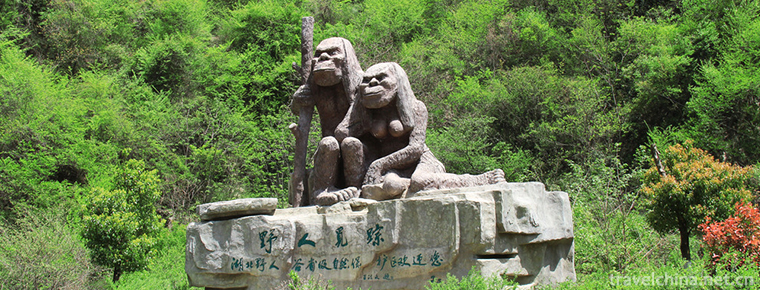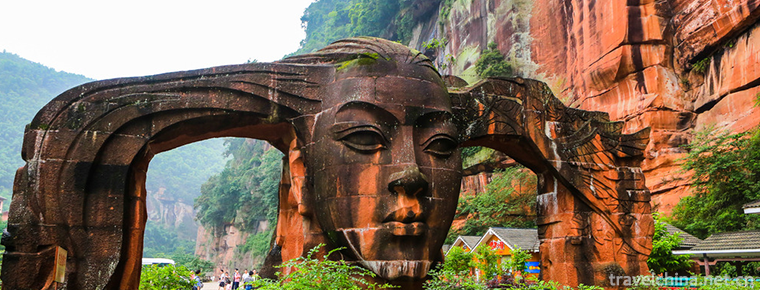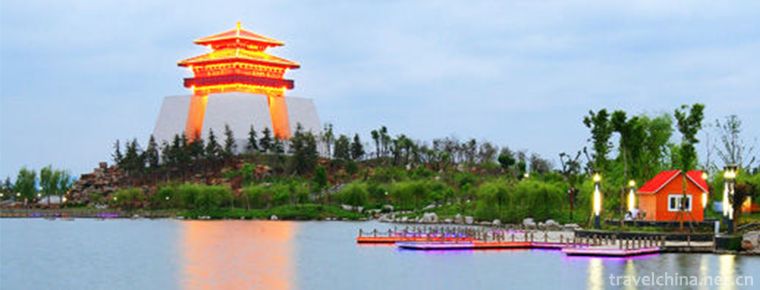Shennongjia Forestry DistrictHubei Shennongjia
Shennongjia Forest District, referred to as Shennongjia for short, was established in 1970 with the approval of the State Council and directly under the jurisdiction of Hubei Province. It is the only administrative division named after the "forest area" in China. In the Wudang Mountains, Shennongjia, the Three Gorges of the Yangtze River tourism belt. Shennongjia Forest District is located in the west of Hubei Province, bordering Baokang County in Xiangyang City in the east, Wushan County in Chongqing City in the west, the Three Gorges along the Yangtze River in the south, and Fangxian County and Zhushan County in Shiyan City in the north. With a total area of 3,253 square kilometers, the area is situated in the United Nations "World Geopark". It has six towns, two townships, a national nature reserve, a Forestry Administration Bureau of state-owned forestry enterprises, and a national wetland park, accounting for more than 85% of the total area.
In 2013, Shennongjia forest region achieved GDP of 1 billion 857 million 450 thousand yuan, an increase of 9.8% over 2012. Among them, the added value of the primary industry was 177.23 billion yuan, an increase of 5.0 percent over 2012; the added value of the secondary industry was 766.65 billion yuan, an increase of 9.7 percent over 2012; and the added value of the tertiary industry was 913.57 billion yuan, an increase of 10.9 percent over 2012. The proportion of the three industrial structure was adjusted from 9.8:42.1:48.1 in 2012 to 9.5:41.3:49.2.
Shennongjia is the first "three crowns" list heritage site jointly entered by UNESCO and the three major protection systems of the biosphere nature reserve, the world geological park and the world heritage. On July 17, 2016, at the 40th World Heritage Congress in Istanbul, Turkey, China's Hubei Shennongjia was listed on the World Heritage List, becoming the first place in Hubei Province and the eleventh in China.in August 7, 2018, the Hubei provincial government approved Shennongjia forest region to withdraw from poverty-stricken counties. was awarded the title of "China's natural oxygen bar" in September 2018.
Shennongjia was named for its ancestor, Emperor Yandi Shennong, who used this wooden ladder as a ladder to collect hundreds of grasses, save people from dying and teach them to grow crops.
In May 1970, the State Council approved the division of Fangxian, Xingshan, Badong's 24 communes, 2 medicinal herb farms and 1 farm into Shennongjia Forest District, which is the only provincial administrative region in China named after the "forest region".
It was placed under the jurisdiction of the Yichang Revolutionary Committee in 1971.
March 1972 returned to the provincial jurisdiction.
In May 1976, it was placed under the jurisdiction of the Revolutionary Committee of Yunyang district.
In August 1983, it returned to Hubei province.
In November 1980, the provincial government approved the establishment of the Shennongjia Forest District People's Government, and revoked the Shennongjia Forest District Revolutionary Committee.
In 1985, the 3 villages of Badong, such as the lower valley, the stone mill and the Banqiao River, were transferred to Shennongjia forest region.
In 1996, Shennongjia forest region had an area of 3253 square kilometers, with a population of about 79 thousand people. Jurisdiction over three towns, 12 townships: Songbai Town, Yangri Town, Muyu Town, Xinhua Township, Changfang Township, Songluo Township, Panshui Township, Guanfeng Township, Tianjiashan Township, Hongju Township, Bancang Township, Dongxi Township, Jiuhu Township, Honghua Township, Xiaguping Tujia. District Government in Song Bai town.
According to the fifth census in 2000, the total population of Shennongjia forest region was 78 242, of which (5 towns and 8 townships): 25 407 in Songbai Town, 11 493 in Yangri Town, 5174 in Muyu Town, 5714 in Honghua Town, 2239 in Hongping Town, 4053 in Xinhua Township, 8171 in Songluo Township, 1644 in Guanfeng Township, 1668 in Hongjuxiang, 1322 in Bancang Township, Dongxi Township. There are 2374 people, 2383 in the big nine lakes and 6600 in the Tujia Township in the lower valley.
By the end of 2004, Shennongjia forest region had an area of 3253 square kilometers and a population of 78 thousand and 700. Xia Songbai, Yang RI, Mu Yu, Hong Ping 4 towns and Xinhua, song Luo, nine lakes, and lower valley 4 township. There are 7 neighborhood committees and 71 administrative villages.
At the end of 2005, Shennongjia Forest District has four townships: Pine and Cypress, Yangri, Muyu, Hongping, Xinhua, Songluo, Jiuhu and Xiaguping. There are 8 neighborhood committees and 65 administrative villages.
In 2009, Xinhua Township was abolished and Xinhua Township was established. The administrative area of Xinhua Township was the administrative area of Xinhua Township and the town government was stationed in Zhangshuping. At the end of 2009, the total area of Shennongjia forest region was 3215.83 square kilometers, with a total population of 80321. Jurisdiction over five towns, three townships: Songbai Town, Yangri Town, Hongping Town, Muyu Town, Xinhua Town, Songluo Township, Jiuhu Township, Xiagu Ping Tujia Township, a total of 68 administrative villages, nine neighborhood committees, 328 villagers group.
In the sixth census in 2010, there were 76140 permanent residents in Shennongjia Forest District, including 31207 in Songbai Town, 10085 in Yangri Town, 9089 in Muyu Town, 5901 in Hongping Town, 3688 in Xinhua Town, 6609 in Songluo Township, 3657 in Jiuhu Township and 5904 in Xiaguping Tujia Township.
Shennongjia Forest District now has six towns and two townships: Songbai Town, Yangri Town, Hongping Town, Muyu Town, Xinhua Town, Jiuhu Town, Songluo Township and Xiagu Pingtu Tujia Township.
In 2013, Shennongjia forest region administered 5 towns, 3 townships, 68 administrative villages, 9 communities and 328 villagers' groups. Among them, 5 towns are Songbai Town, Yangri Town, Muyu Town, Hongping Town and Xinhua Town; 3 townships are Songluo Township, Jiuhu Township and Xiaguping Tujia Nationality Township. forest Government No. 18, Changqing Road, song Bo Town.
Shennongjia forest region (longitude 109, latitude 31 6550
From the end of Indosinian movement to the beginning of Yanshan movement, strong folds and large area tilting occurred in Shennongjia forest area, which laid the geomorphological framework of the area. Quaternary climate changes in the cold and warm, in some parts of the remaining glacial landforms, resulting in complex and diverse landforms in the region. The Shennongjia Mountains lie in the southwest of the Shennongjia Forest Region in East-West direction, with the highest height of Shennongding, 3105.4 meters, which is also the highest point in central China; the lowest point in the forest region is Shizhu River in Xiaguping Township, with an elevation of 398 meters and a relative height difference of 2707.4 meters. According to the geomorphic morphological characteristics and genetic types in the area, it can be divided into four types of geomorphic units: tectonic dissolution geomorphology, dissolution erosion geomorphology, denudation erosion geomorphology and accumulation geomorphology.
The agricultural shelf belongs to the north subtropical monsoon climate zone, which is a transition zone from subtropical climate to temperate climate. It is humid and rainy in summer, mild and rainy in winter. The annual radiation is 103.7 kcal/m2, and the annual sunshine hours are 1858.3 hours. The sunshine hours and total radiation decrease with the increase of altitude. The annual average temperature frost-free period varies greatly with the altitude. The annual precipitation is between 800 and 2500 millimeters, and the precipitation increases with the increase of altitude. Frost often occurs at the turn of spring and summer, usually from the end of September to the end of April. The average annual evaporation is 500 - 800 mm, and the drought index is 0.50 - 0.53. The east wind prevailed in 80% of the whole year.
Tian Yan original eco-tourism area
The Tian Yan original eco-tourism area is located in the northwest of Shennongjia, with a total area of about 926.24 square kilometers. It is a primitive eco-tourism area with primitive forest scenery as its background, Shennong legend and simple mountain forest culture as its connotation, which integrates exotic trees, flowers, caves, peaks and folk customs, and reflects primitive and ancient times and explores mysteries. The vast forests and seas in the scenic area are full of beautiful things, especially with the characteristics of "majesty, beauty, seclusion and wilderness".
Located at the intersection of the north and the south of China, the natural vegetation in this area can be divided into coniferous forest, broad-leaved forest, bamboo forest, shrub, mountain grassland, meadow, swamp and other vegetation types. The abundant animal and plant resources are very observable, and the air is fresh, and the environment is surrounded. Quiet environment is a good place to carry out green tourism. The main attractions are Yanzi Cave, Yantianfeidu, Huixianqiao, Yanziya, Xue Gangzhai, Tianmenya, Liu Hengzhai, Shanbao Cave, Zizhuhe Primitive Forest, Yunhai Foguang, Hongping Gallery, Baicao, Taping Mountain Forest Pastoral Scenery and Folk Customs.
Shennongjia national Forest Park
Shennongjia National Forest Park is located in the northwest of Hubei Province. It is composed of Fangxian, Xingshan and Badong counties with an area of 3 250 square kilometers, accounting for more than 85% of the forest land and 69.5% of the forest coverage. The area is inhabited by Han, Tujia and Hui nationalities with a population of nearly 80,000. The highest peak of Shennongjia is 3105.4 meters above sea level, the lowest is 398 meters above sea level, the square altitude is 1700 meters, and there are 6 peaks above 3000 meters. It is known as the "Central China Roof".
Local folklore
Shennongjia is the gathering place of Yin and Shang culture, Qin and Han culture, Bashu culture and Jing and Chu culture. The regional folk culture resources are rich and various. The precious Han mythological epic "Dark Biography", beautiful lyric folk songs and colorful legends constitute the treasure house of Shennongjia folk literature, as well as a powerful witness to the existence of ancient culture in Shennongjia before the last century. Because of the primitive closed state for a long time, the special natural ecology and geographical environment, people are deeply influenced by traditional ideas, beliefs, production methods and lifestyles, forming and preserving a variety of ancient and simple customs, marriage customs, funeral customs, wine customs, food and other folk customs with obvious local characteristics, Tang (Tang) opera, Tang (Tang) opera, Tang (Tang), Tang (Tang) opera), Tang (Tang) opera), Tang (Tang) opera), Tang Shadow play, drumming drums, hunting, grass and gongs and drums, artillery guns and hanging pots have become the main form of expression. Pine and cypress, Hongping, Xiagu, Jiuhu, Xinhua, Songluo and other towns are distributed, covering the country divided into ten categories, more than 40 sub-categories.
Folklore
Shennongjia's name is related to an ancient legend about Shennong tasting hundreds of grasses. In ancient times, the emperor of Shennong found a high mountain for people to taste hundreds of grasses. But when he saw the steep mountain and the forest, he was overjoyed that there must be a secret collection of miracle drugs. He first taught the people to build wood as a house to avoid danger, followed by the people to build wood as a ladder to help climb; collected 400 kinds of good medicine, and wrote the "Shennong Herbal Classic", in order to revert to the Emperor of Heaven, before "building wood as an altar, flying cranes" away. The descendants remembered the ancestor and ender, and called this mountain Shennongjia.
The legendary Shen Nong emperor is the Emperor Yan Nong. Shennong tasted all kinds of herbs and prospered in Chinese medicine. Therefore, it has 95 noble status in common people's mind. The Shennongjia Mountains are still known as the "Natural Pharmacy Garden" because it is rich in medicinal plants, which are divided into three categories: woody, vine and herbal. Hundreds of them have the function of nourishing and nourishing the face. Dozens of them are rich in anti-cancer and anti-cancer elements.
It is said that the interpretation of the word "rack" is very comprehensive and convincing. Because the precious medicinal materials in Shennongjia are demanding for habitat, the most representative is the golden hairpin. Gold brass is a Dendrobium family plants, according to the shape is divided into herringbone gold brass, bean sprouts gold brass, dragon head and Phoenix Tail Gold Brass and so on. Among them, the dragon head Fengwei Golden Chai is the most rare and precious, because it requires growth on the cliff top, but also requires the bottom of the abyss, but also the reflection of the sun and moon just fall back to the cliff head, one of the three indispensable. It is precisely because of such a habitat, Jin Chai was able to make the best of the world, the essence of the sun and the moon, and ranked first among the seventy-two returned penis. To collect gold, drug farmers must first select the right place to "frame the wood for the house", and then select the right material "frame the wood for the ladder", ladder includes hard and soft two kinds, wooden ladder is mainly used for climbing cliffs, rope ladder is mainly used for hanging in the air.
As for the "wooden altar, across the crane flying in the sky," it is obviously with mythological color, but for Emperor Yan Shennong is not excessive. The ridge line on the west side of Tianmenya is trapezoidal and the top of the ridge is towering. It is said that this is the site of Shennong's "building a wooden altar, flying across a crane" and the valley under the mountain is full of purple bamboo. It is said that bamboo engraved in the "Shennong Materia Medica Sutra" is simplified into bamboo.
In September 26, 2018, Shennongjia forest region was awarded the regional title of "China's natural oxygen bar" in 2018.














-
About Us
If you are interested in Chinese culture, Beautiful Scenery and Delicious Food, Welcome to China..
Views: 360 Time 2018-09-28 -
Danxia Chishui
Danxia National Geopark in Chishui City, Guizhou Province, is located in the southern edge of Sichuan Basin, close to the northern foot of Daloushan Mountain in northern Guizhou Province and the weste.
Views: 214 Time 2019-01-05 -
Zaozhuang Old Street Shuicheng South Shandong
Shuicheng Zaozhuang Old Street in Southern Shandong Province is located in the middle section of Xichang Road in the Central District of Zaozhuang City, Shandong Province. .
Views: 154 Time 2019-02-06 -
Western Royal Tombs of the Qing Dynasty
Xiling Tomb of Qing Dynasty is located at the foot of Yongning Mountain, 15 kilometers west of Yixian Town, Baoding City, Hebei Province, more than 120 kilometers away from Beijing.
Views: 183 Time 2019-02-07 -
Caogao Gong and drum in northern Sichuan
Licao Gong and drum in northern Sichuan is a kind of traditional folk music. It mainly distributes in four counties and three districts of Guangyuan City, Sichuan Province.
Views: 374 Time 2019-04-18 -
Mianzhu Wood Engraving New Year Picture
Mianzhu New Year Picture, also known as Mianzhu Wood Printing New Year Picture, is one of the Chinese Folk Woodcut New Year Pictures. It is named for Mianzhu City, Sichuan Province.
Views: 66 Time 2019-06-04 -
Cross stitch
Flower picking, a kind of drawing work, also refers to a needle method of embroidery, Chinese folk traditional handicraft. Also known as "pick weave", "cross embroidery", "cro.
Views: 230 Time 2019-06-21 -
Mount Emei Jinding
Mt. Emei Jinding, also known as Huazang temple, is located on the main peak of Emei Mountain in Sichuan Province, China (29.52567 ° n, 103.336802 ° E), with an altitude of 3077 m. It is the end point of Emei Mountain tour and one of the key Buddhist temples in the Han area..
Views: 325 Time 2020-10-15 -
The origin of Chinese embroidery
Embroidery originated very early. The article on the embroidery of Fu Yu can be seen in Shangshu. In the time of Yu Shun, embroidery was already in use. In the Eastern Zhou Dynasty, there was an official in charge of it, and in the Han Dynasty, there was Royal embroidery.
Views: 102 Time 2020-12-12 -
Deyang first industry
In 2018, the sown area of crops in Deyang City was 477000 hectares, 533 hectares less than the previous year, a decrease of 0.1%. Among them, the sown area of grain crops was 311000 ha, decreased by 1525 ha, decreased by 0.5%; the sown area of oil .
Views: 126 Time 2020-12-14 -
Guangan science and technology
In 2019, 16 new high-tech enterprises will be cultivated in Guang'an City, 107 of which will be put on record by the Ministry of science and technology. One provincial high-tech industrial park, one provincial engineering technology research center and two.
Views: 345 Time 2020-12-19 -
Dazhou folk culture
Dazhou yuanjiu Climbing Festival this tradition has been followed for thousands of years, every year on the ninth day of the first month, hundreds of thousands of people travel to the city, this spectacular scene is also rare in the country. It is said that i.
Views: 288 Time 2020-12-20







